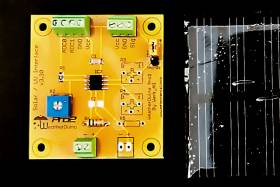
Solar Radiation / UV Interface
Overview
It is important to measure solar radiation because this is the primary energy source for many biophysical processes on the Earth, but this is more difficult than measuring temperature or rainfall, for example. However, it is possible to make reasonably accurate measurements of solar radiation with relatively simple equipment, provided care is taken with the design, siting and calibration of the sensor. The WeatherDuino system is well-suited to making routine measurements of solar radiation at low cost and it also offers a platform for experimenting with more advanced solar sensors.
In common with many other weather stations, the WeatherDuino system uses a silicon sensor to measure the Sun's radiant energy rather than a much more expensive thermopile. This means that not all the Sun's energy is measured, as silicon devices are only sensitive over the wavelength range 0.4 -1.1 micrometres (approx), whereas the energy from the Sun reaching the Earth's surface is distributed over 0.3 - 3.0 micrometres (approx). Accurate intercalibration between a silicon solar sensor and a thermopile is never going to be possible because of this discrepancy, but fortunately the amount of solar energy is the 'missing' part of the electromagnetic spectrum is relatively small, especially in areas with a lot of water vapour in the atmosphere.
On the plus side, it is worth noting that a silicon solar sensor is uniquely suited to measuring the solar energy available to a PV solar power generation system based on silicon photovoltaic cells, so for many practical purposes the approach adopted by the WeatherDuino project has much to commend it.
The Solar Radiation / UV interface can be used with commercially available silicon photodiode pyranometers, provided their output voltage does not exceed 1.1V, for example the Apogee SP-110 Pyranometer. Although much cheaper than a professional thermopile pyranometer, commercial silicon photodiode pyranometers are still expensive, probably costing far more than the rest of the weather station combined. For this reason the WeatherDuino project is primarily designed to use a simple solar sensor based on a design by Charles G. Wright which uses a silicon photovoltaic cell, see Measuring Solar Radiation.
Despite its simplicity, a solar radiation sensor based on a photovoltaic panel works well, and its readings are comparable to those from expensive silicon photodiode pyranometers.
For UV index, we have chosen to use the UVM-30A UV sensor.
Solar Radiation / UV interface - What is included?
Usually the Solar Radiation / UV interface is supplied as a kit that includes the fully assembled interface, plus a tested miniature photovoltaic panel. The op amp gain is pre-calibrated for the supplied photovoltaic panel, allowing solar radiation readings up to 1500 W/m2 . Optionally it can be supplied without the photovoltaic panel.
The UVM-30A UV sensor for UV Index isn't included. This sensor is easy to find, costs around 5€, and can be bought from several sellers on eBay or other sources.

Things to consider...
The easiest way to measure solar radiation data with your weather station is by using the Solar / UV interface with a ready made silicon photodiode pyranometer, such as the Apogee SP-110. Note that a special levelling fixture is also required to ensure that pyranometer is perfectly horizontal. Ideally, the sensor should be mounted so that it has an unobstructed view of the sky from dawn to dusk. In practice, this is often impossible if the site has buildings or tall trees nearby. Also bear in mind that you will need to access the sensor to check that it is horizontal and to clean it occasionally.
The WeatherDuino silicon pyranometer uses a small photovoltaic panel instead of a silicon photodiode. This unconventional approach has the advantage of being easy to set horizontal, so angular errors are reduced. In the WeatherDuino support forum there is an extensive article on this topic which we strongly recommend you read: Measuring Solar Radiation based on Photovoltaic Cells.
Installing the photovoltaic panel and the UV sensor in a suitable weatherproof housing is not straightforward.
For instance, the material used to cover the sensors should not block or reduce UV radiation. You are recommended to use fused silica, a type of glass that its almost transparent to UV rays.
Example of a commercial pyranometer that uses a miniature photovoltaic panel.  |
Additional Information
Calibration
Accurate calibration of a pyranometer is challenging even with expensive specialist equipment so we have to be realistic about what can be achieved. Commercial solar sensors are generally supplied with a calibration traceable to a national standard, which is one reason they are so expensive. If bought as a complete unit, the sensitivity of the WeatherDuino solar sensor will have been adjusted to provide an approximate calibration. This means that under ideal conditions the solar irradiance measured by the WeatherDuino solar sensor should be similar to the theoretical maximum value, taking into account the latitude and longitude of the site, the time and the date. 'Ideal conditions' in this context means a cloudless day with excellent visibility, and the best time to make the comparison is around noon in mid-summer. The Sun's rays travel through the minumum thickness of atmosphere at noon in mid-summer, and the rate of change of the solar incident angle is least around noon, so irradiance values are relatively stable.
The theoretical maximum solar irradiance for any location at any day of the year can be found using the Apogee Clear Sky Calculator or, if you are using the Cumulus MX software it is shown on the same chart as the measured solar irradiance. Any mismatch between the theoretical maximum and that measured can reduced by adjusting the scaling factors in the Cumulus software. Note, however, that occasional values in excess of the theoretical maximum are possible, especially at the edges of clouds where the irradiance may be enhanced.